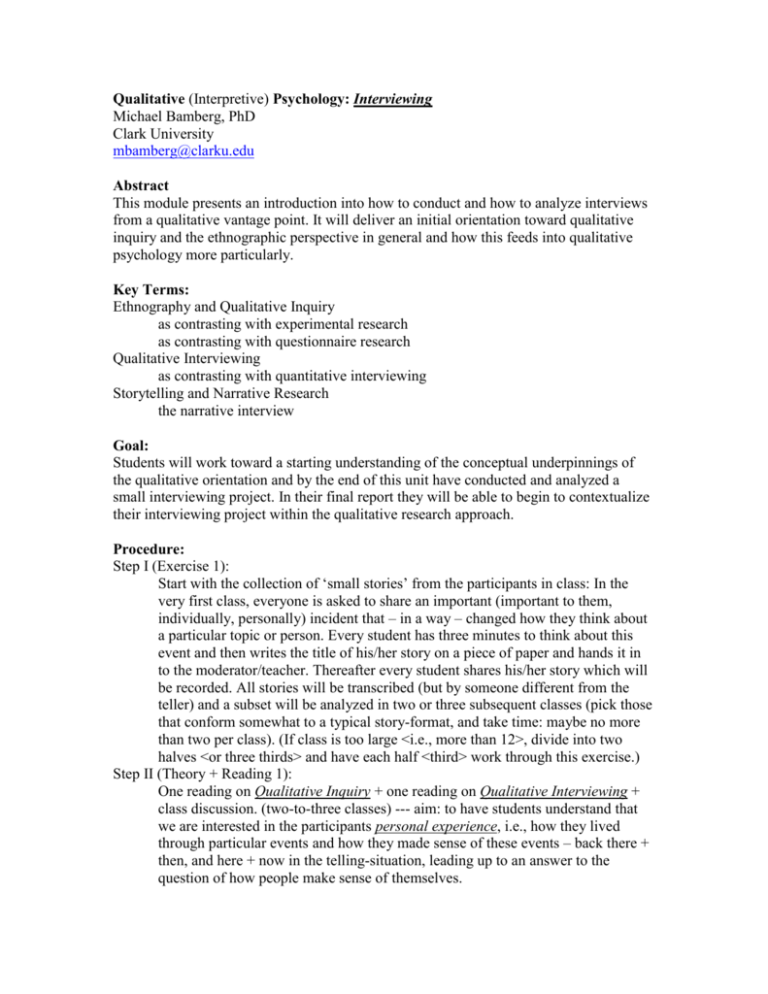Qualitative (Interpretive) Psychology: Interviewing
advertisement

Qualitative (Interpretive) Psychology: Interviewing Michael Bamberg, PhD Clark University mbamberg@clarku.edu Abstract This module presents an introduction into how to conduct and how to analyze interviews from a qualitative vantage point. It will deliver an initial orientation toward qualitative inquiry and the ethnographic perspective in general and how this feeds into qualitative psychology more particularly. Key Terms: Ethnography and Qualitative Inquiry as contrasting with experimental research as contrasting with questionnaire research Qualitative Interviewing as contrasting with quantitative interviewing Storytelling and Narrative Research the narrative interview Goal: Students will work toward a starting understanding of the conceptual underpinnings of the qualitative orientation and by the end of this unit have conducted and analyzed a small interviewing project. In their final report they will be able to begin to contextualize their interviewing project within the qualitative research approach. Procedure: Step I (Exercise 1): Start with the collection of ‘small stories’ from the participants in class: In the very first class, everyone is asked to share an important (important to them, individually, personally) incident that – in a way – changed how they think about a particular topic or person. Every student has three minutes to think about this event and then writes the title of his/her story on a piece of paper and hands it in to the moderator/teacher. Thereafter every student shares his/her story which will be recorded. All stories will be transcribed (but by someone different from the teller) and a subset will be analyzed in two or three subsequent classes (pick those that conform somewhat to a typical story-format, and take time: maybe no more than two per class). (If class is too large <i.e., more than 12>, divide into two halves <or three thirds> and have each half <third> work through this exercise.) Step II (Theory + Reading 1): One reading on Qualitative Inquiry + one reading on Qualitative Interviewing + class discussion. (two-to-three classes) --- aim: to have students understand that we are interested in the participants personal experience, i.e., how they lived through particular events and how they made sense of these events – back there + then, and here + now in the telling-situation, leading up to an answer to the question of how people make sense of themselves. Step III (Exercise 2): Divide class into small groups (each group consisting of 3 – maybe 4, but not 2 students) and set them up to interview members of the other groups. Each group has to come up with a list of interview topics that they (as a group) will have to justify and discuss with the teacher/moderator who will help the group pick one of the topics. The chosen topic should be somewhat personal (but not too personal!) but at the same time of interest (it can range on shared experiences such as ‘middle school’, ‘transition to high school’, ‘moving and/or changes in neighborhood’, ‘food preferences’; ‘friendship’, ‘TV-habits’, ‘videogames’, and the like). Each group will work their topic up into an interview schedule – consisting of a sequence of interview questions that is supposed to help the interviewee to unpack the experience or experiences on ‘the particular topic’. Here it is important that it becomes clear that interviewing is NOT to simply get “the information” but to engage the interviewee in relating what the experience was (back the) and what the experience meant and still means. Therefore, students need to be trained in being supportive, withholding their own opinions and giving the participants space to form and elaborate on their opinions. This will result in conducting (and taping) an individual interview by each student with an interviewee (from a different group) on the same (group) topic. Example: Four groups (each consisting of three students): Group 1 developed as their interview topic X <<e.g. an accident>> Group 2 developed topic Y <<e.g. my first day in High School>> Group 3 topic Z <<e.g. my best vacation experience>> Group 4 <<e.g. an interesting family festivity (wedding of a close relative, Passover, Christmas…)>> ---the three students from group 1 will conduct three individual interviews on the topic of X with the three members of group 2 ---the three students from group 2 will conduct three individual interviews on the topic of Z with the three members of group 3 ---and so on… This will result in 12 individual interviews (all individually conducted, though in a group spirit: where the students in the same group can share their experiences with each other, and they all - as a group - with other groups) on four different topics. Step IV <inserted in Step III> (Reading): How to conduct ‘good interviewing – where interviewing techniques are given as examples and discussed in class Step V(A) (Life Story Project Preparation): Ads will be put together and placed in Old People’s Homes – searching for participants who are willing to participate by sharing their life stories. (One group will put this ad together, another group will place it, a third group will make contacts, and a fourth group will arrange the dates for the interviews.) Step V(B) (Life Story Interview Planning): In class every student will develop an interview plan for a life story interview Step V(C) (Life Story Interviewing) Conducting + taping the interview Step VI (Life Story Analysis/Evaluation) Every student will write a summary of the interviewee’s life story and reflect on the interview and what the interview facilitated in terms of a glimpse into someone’s life. All this is part of the final report, including some reflections on interviewing as a qualitative research technique. Analytic Approaches: In principle, there are three different kinds of analyses of this kind of data: a discursive psychological approach o a more discourse/linguistic analytic approach to reveal the ‘ideological positions’ and ‘master narratives’ that are underlying the participants’ use of discursive (language) patterns; usually used to reveal the strategies used to make sense and display a sense of self a phenomenological approach o more descriptive than ‘analytic-critical’, usually used to reveal the kind of ‘subjectivity’ (sense of self) displayed in the data a social psychoanalytic approach o identifying the key social psychoanalytic concepts used in psychoanalytic analysis (such as ‘anxiety’, ‘unconscious’, ‘projective identification, and ‘defense mechanisms’) – requires an awareness of the psychodynamics between the interviewer and interviewee Working with High School students through this project my suggestion is to use the second, the ‘phenomenological’, approach resulting in a summary description of the participants life and how they make sense of it. <<I will provide literature on these three approaches if needed.>> Human Subjects Proposal: For Step III (exercise 2) each group develops a short proposal for the institutional review board, and a ‘Consent Form’. These will be discussed in class before the Human Subjects Proposal and the Consent Form for the Life Story Project are put together. This will be done jointly – with the assistance of the Clark University Web page: Application Form: http://www.clarku.edu/offices/research/compliance/humsubj/applicationform.cfm Checklist: http://www.clarku.edu/offices/research/compliance/humsubj/checklist.cfm CAVEAT: Please make sure that this type of research interviewing is not confused with ‘Clinical Interviewing’. The module consists of a project that trains students in an overall approach to research, associated with a particular methodological and theoretical perspective that is grounded in a particular epistemology and ontology. And although these perspectives can not be fully unfolded with the students, research interviewing should not come across as a-theoretical, unsubstantiated or eclectic. Readings for module on QUALITATIVE PSYCHOLOGY: Interviewing 1) Excerpts from Denzin, N.K., & Lincoln, Y.S. (2000). Introduction. In N.K. Denzin & Y.S. Lincoln (Eds.), Handbook of qualitative research (second edition) (pp. 1-28). Thousand Oaks, CA: Sage Brief Summary: these are some introductory paragraphs into how qualitative methods are different from quantitative . This can be easily replaced by something more simple or more elaborate – if time allows. But the purpose of these few paragraphs is to broadly acquaint the students with the different orientations and at the same time underscore our interest in ‘others’. 2) Excerpts from Vidich, A.J., & Lyman, S.M. (2000). Qualtative methods. Their history in Sociology and Anthropology. In N.K. Denzin & Y.S. Lincoln (Eds.), Handbook of qualitative research (second edition) (pp. 37-84). Thousand Oaks, CA: Sage Brief Summary: These excerpts pick up where the previous excerpts ended, namely in our interest in ‘others’ – refined here under the umbrella notion of ‘ethnography’. Hopefully, students will take away from this that everyday people and everyday phenomena indeed are interesting and worthy of studying. 3) Excerpts from Fontana, A., & Frey, J.H. (2000). The interview: From structured questions to negotiated text. In N.K. Denzin & Y.S. Lincoln (Eds.), (second edition) (pp. 645-672). Thousand Oaks, CA: Sage Brief summary: These excerpts introduce into the use of interviews – historically, theoretically and practically. 4) Excerpts from Bogdan, R.C., & Biklen, S.K. (2003). Qualitative research for education. An introduction to theory and methods (fourth edition). Boston, MA: Allyn & Bacon. Brief Summary: These excerpts follow up on the previous excerpts and give some examples with regard to topics. 5) Atkinson, R. (2007). The life story interview as a bridge in narrative inquiry. In D.J. Clandidnin (Ed.), Handbook of narrative inquiry (pp. 224-245). Thousand Oaks, CA: Sage. Brief Summary: This chapter introduces explicitly into the kind of narrative interview the students are expected to conduct – the Life Story Interview 6) Practical Suggestions (3pp) And finally a handful of tips how to do interviewing. Further references for teachers who are preparing this module will be added May 2nd, 2007






